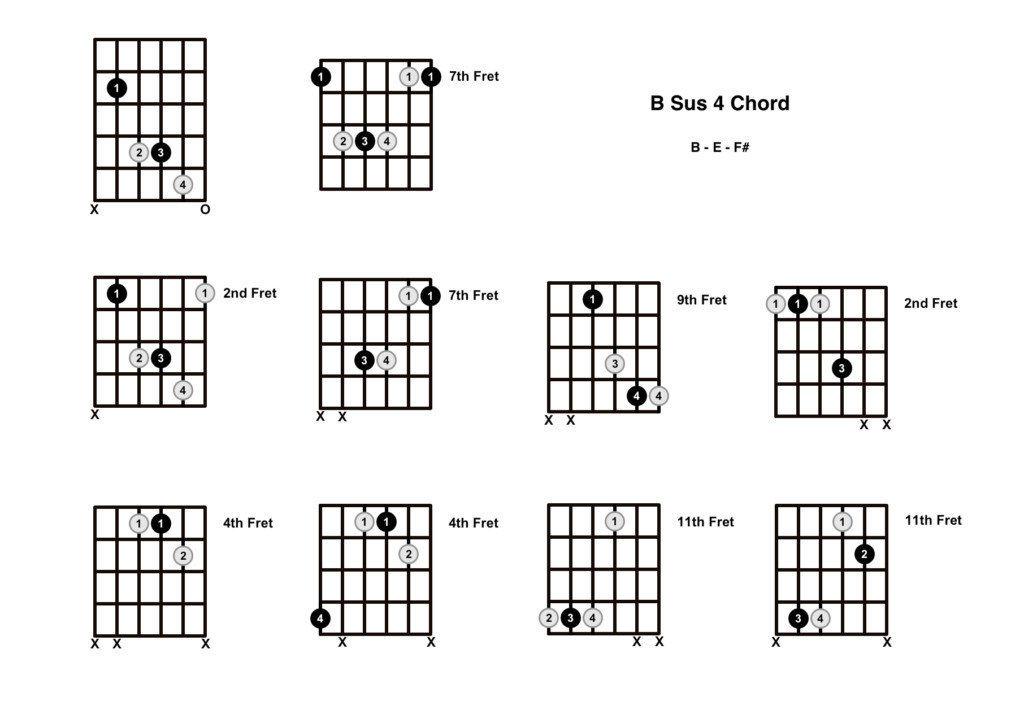The B sus 4 chord is a captivating and versatile chord in the guitarist’s toolkit. Often used to add a touch of melodic interest and harmonic color, the B sus 4, or B suspended fourth chord, offers a unique sonic texture compared to its major and minor counterparts. This guide will delve into the essence of the B sus 4 chord, exploring its construction, various shapes across the fretboard, and how to effectively use it in your guitar playing.
Understanding the B Sus 4 Chord
At its core, the B sus 4 chord is built upon the B Major scale. It’s a variation of the standard B Major chord, but with a crucial alteration that creates its signature ‘suspended’ sound. To understand this, let’s break down the components:
- Notes: The B sus 4 chord is composed of three notes: B, E, and F#.
- Intervals: These notes correspond to the 1st (root), 4th, and 5th degrees of the B Major scale.
- Construction: Essentially, the B sus 4 chord takes a B Major chord and replaces the 3rd degree (D#) with the 4th degree (E).
This substitution is what gives the sus 4 chord its characteristic sound. By removing the major third, the chord loses its definitive major or minor quality, creating a sense of harmonic ambiguity and openness. The added fourth interval (E) creates a suspended feeling, a tension that often seeks resolution.
The Suspended Sound and its Musical Application
The term “suspended” accurately describes the sonic quality of the B sus 4 chord. The absence of the third and the presence of the fourth create a feeling of harmonic suspension, a tension that feels like it needs to resolve, typically to a major or minor chord.
A common and effective way to hear and utilize this tension and resolution is through a simple chord progression:
B Major – B sus 4 – B Major
Strumming this sequence allows you to clearly hear the effect of the B sus 4. Moving from the stable B Major to the B sus 4 introduces a noticeable tension. Then, returning to the B Major chord provides a satisfying harmonic resolution.
This characteristic makes the B sus 4 chord a fantastic tool for:
- Adding Flavor to Major Chords: The B sus 4 can be used as a momentary substitute for the B Major chord, injecting a brief moment of harmonic interest and movement into progressions.
- Creating Melodic Interest: The suspended sound adds a layer of melodic intrigue, making chord progressions less predictable and more engaging.
- Building Tension and Release: As demonstrated in the progression above, the B sus 4 is perfect for creating harmonic tension that can be resolved in various musical contexts.
Exploring Different Shapes for the B Sus 4 Chord
One of the joys of guitar playing is discovering multiple ways to play the same chord. The B sus 4 chord is no exception. While often introduced in the open position, there are numerous shapes across the fretboard that offer different voicings and facilitate smooth transitions in various musical situations.
Here are several shapes for the B sus 4 chord, expanding on the common open position:
(Insert Image of B Sus 4 Chord 10 Shapes here. Use the original image URL)
 B Sus 4 Chord Diagrams for Guitar
B Sus 4 Chord Diagrams for Guitar
- Open Position (Shape 1 in image): This is often the first B sus 4 shape learned. It’s relatively easy to fret and is excellent for beginners.
- Barre Chord Shapes: By adapting standard barre chord shapes, you can play the B sus 4 chord higher up the neck. These shapes offer a fuller, more powerful sound and are essential for playing in different keys and positions.
- Movable Shapes: Understanding the intervallic structure of the B sus 4 allows you to create movable shapes that can be played anywhere on the fretboard. This knowledge unlocks greater flexibility and creativity in your playing.
Experimenting with these different shapes will not only expand your chord vocabulary but also enhance your understanding of chord construction and fretboard navigation. Each shape offers a slightly different voicing, making some shapes more suitable for certain musical contexts than others.
Quick Theory Recap of the B Sus 4 Chord
To solidify your understanding, let’s revisit the key theoretical points:
- Notes: B, E, F#
- Scale Degrees: 1st (Root), 4th, 5th of the B Major Scale
- Relationship to B Major: B sus 4 removes the 3rd of the B Major chord (D#) and adds the 4th (E).
- Resolution: B sus 4 often resolves naturally to B Major, creating a satisfying harmonic movement.
- Suspended Sound: The 4th interval (E) creates a suspended quality, generating harmonic tension.
Integrating the B Sus 4 Chord into Your Guitar Playing
Now that you understand the theory and have some shapes under your fingers, how can you effectively use the B sus 4 chord in your music?
- Chord Progressions: Experiment with substituting the B sus 4 for the B Major in common chord progressions. Listen to how it alters the feel and adds interest.
- Songwriting: Incorporate the B sus 4 to create moments of tension and release in your own compositions. It can be particularly effective in intros, verses, and bridges.
- Improvisation: Use the B sus 4 as a harmonic color to explore during improvisations, particularly over major key centers.
- Fingerpicking and Strumming: The B sus 4 sounds great in both fingerpicked and strummed contexts. Explore different rhythmic patterns and techniques to bring out its unique character.
By actively experimenting and listening, you’ll discover the many ways the B sus 4 chord can enrich your guitar playing and musical expression. It’s a chord that offers both subtle nuance and powerful harmonic impact, making it a valuable addition to any guitarist’s repertoire.
(Optional: Further Reading/Call to Action – Could link to other chord lessons or resources on guitarplayers.net here)
